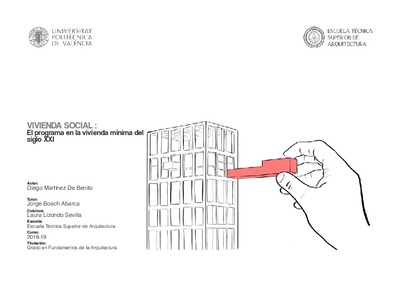|
Resumen:
|
[ES] El presente trabajo versa sobre la vivienda mínima social, ahondando en la cuestión del programa y en las diferencias que surgen en torno a este tema entre en los siglos XIX y XX comparados con la situación actual.
A ...[+]
[ES] El presente trabajo versa sobre la vivienda mínima social, ahondando en la cuestión del programa y en las diferencias que surgen en torno a este tema entre en los siglos XIX y XX comparados con la situación actual.
A través del estudio y recopilación de textos analizaremos los problemas y necesidades a las que se enfrentaba el programa de la vivienda social en los siglos XIX y XX para poder compararlas con las necesidades del siglo XXI.
De esta forma, el objetivo del trabajo será proponer una actualización del programa adaptado a la problemática de la vivienda actual, además de demostrar que a través de este se pueden solventar las necesidades de la clase trabajadora de hoy en día.
Para ello, se definirán tres fases del proyecto.
La primera fase consta de un recorrido histórico de las viviendas sociales empezando desde la Revolución Industrial, donde el éxodo rural obligó a hacinar a grandes masas de población en pequeños espacios, enunciando también las condiciones de habitabilidad en las que vivía el proletariado.
A continuación, se estudiarán los textos y ensayos escritos por arquitectos tanto del siglo XIX como XX que teorizaron sobre la cuestión de la vivienda social, haciendo hincapié en aquellos que hablen del programa y las necesidades, así como la posterior influencia que ejercieron en la reconstrucción de ciudades tras la Segunda Guerra Mundial.
La segunda fase trata de exponer las diferencias en las necesidades de la clase obrera en los siglos pasados y hoy día. Para ello, se analizarán ensayos y textos de este último siglo que versen sobre el tema, para así poder realizar una comparación y una posterior síntesis de lo estudiado.
Una vez enumeradas las necesidades actuales se desarrollará la tercera fase del trabajo, que tiene como objetivo mostrar propuestas actuales que traten de resolver esas necesidades a través del programa y de la correcta adecuación funcional de este.
[-]
[EN] This work deals with minimum social housing, focusing in the field of the program and the differences that arise around this statement between the nineteenth and twentieth centuries compared to the current situation.
Through ...[+]
[EN] This work deals with minimum social housing, focusing in the field of the program and the differences that arise around this statement between the nineteenth and twentieth centuries compared to the current situation.
Through the study and compilation of essays we will analyze the problems and needs that social housing program faced in the 19th and 20th centuries in order to compare them with the needs of the 21st century.
In this way, the objective of the work will be to propose an update of the program adapted to the current housing problem, in addition to demonstrating that through this matter, the current needs of the working class can be solved.
The project will be divided in three phases:
The first part consists in a historical approach of social housing starting from the Industrial Revolution, where the rural exodus forced to overcrowd large masses of people in small spaces, also naming the conditions of habitability in which proletariat lived.
Moreover, we will study texts and essays written by architects of both nineteenth and twentieth centuries who theorized on the social housing issue, emphasizing those who talk about program and needs of the dwellings, as well as the subsequent influence they had in the reconstruction of cities after World War II.
The second phase tries to expose the differences between the needs of the working class in past centuries and nowadays. To do this, it will be analyzed essays and texts of this last century that deal with the subject, in order to make a comparison and a later synthesis of the studied.
Once the current needs are listed, the third phase of the work will be developed, which aims to show current proposals that try to solve those needs through the program and the correct functional adaptation of it.
[-]
|







